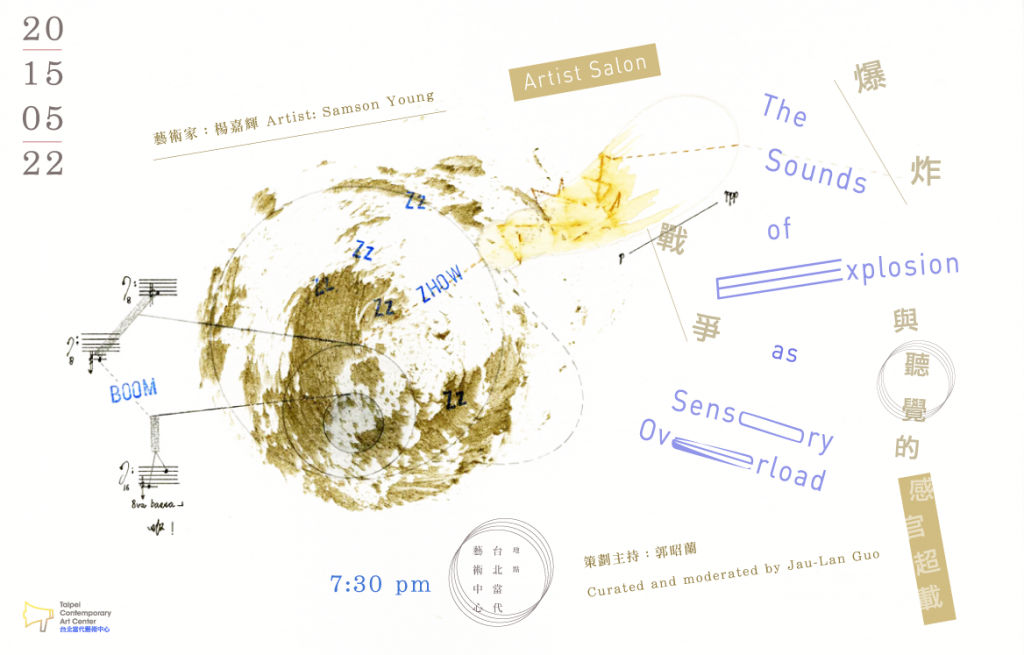For English please scroll down.
爆炸、戰爭、與聽覺的感官超載
時間:5月22日(五),7:3-pm
地點:台北當代藝術中心
藝術家:楊嘉輝
策劃主持:郭昭蘭
藉「聲音可以作為武器嗎?」這個提問,
展名之中的前衛一詞不僅暗示二十世紀前衛藝術的前衛,
講者介紹:
楊嘉輝接受古典音樂及作曲訓練,作品卻不限於聽覺,
郭昭蘭,獨立策展人兼藝術評論者,
Artist Salon: The Sounds of Explosion as Sensory Overload
Time: 22 May, 7:30pm
Venue: Taipei Contemporary Art Center
Artist: Samson Young
Curated and moderated by Jau-Lan Guo
D“Can sound be a weapon?” as the opening question in Samson Young’s latest solo show aVantGaRde oN sPeEd in TKG+ suggests how this Hong Kong born artist attempts to respond to the recent social climate with his artistic practice in sound art, whose culture Young has been exploring for long. This Artist Salon will stage artist’s creative echo to his situated anxiety for Hong Kong’s post-colonial transition and authoritarian political threat as well as the conversations that the artist and curator Jau-Lan Guo have been developing to discuss Young’s artistic concerns and this exhibition.
The term “avant-garde” in the exhibition title implies both the capital Avant-Garde of the 20th century art movement as well as avant-garde in the military terminology. “On speed” draws the association with drugs, acceleration, going nuts, insanity, and so on. The story of soldiers being provided with drugs is not just a rumor. The question lies on the supply system and its legitimization process. Apart from the political implication, aVantGaRdeplays with war tactics and the global geopolitics in the post-colonization era as the background for new sound composition.
About speakers:
Originally trained in music composition, Samson Young’s creative outputs now manifest in a variety of media and across disciplinary divide. His works are seen and heard in galleries, museums, concert halls and performance spaces. In 2007, he became the recipient of the inaugural Bloomberg Emerging Artist Award with his audio-visual project The Happiest Hour,which marked his entry into the worlds of art outside of the concert hall. Other honors include an honorary mention at the digital music and sound art category of Prix Ars Electronica; a Jury Selection award at the 15th Japan Media Art Festival; and the New York Society for New Music Brian M. Israel Prize. CNN’s global portal identified him as one of the “Top 20 People to Watch in Hong Kong,” and in 2013 he was named “Artist of the Year” in the Media Art category by the Hong Kong Arts Development Council. Young received a Ph.D in composition at Princeton University under the supervision of computer music pioneer Paul Lansky. In 2007, he founded the experimental sound advocacy organization Contemporary Musiking. He was Hong Kong Sinfonietta’s Artist Associate in the 2008 – 2009 concert season. He is currently an assistant professor at the School of Creative Media, City University of Hong Kong.
Jau-Lan Guo, independent curator and art critic, associate professor teaching in Taipei National University of the Arts, lives in Taipei, Taiwan. Her dissertation “Robert Rauschenberg’s art in 1960s: Toward Postmodern” explored the intersections of Rauschenberg’s art and postmodern theories and criticism of the 1980s through queer studies, postmodern, and cross-disciplinary methods. While trained as an art historian in American art since 1960, her studies have been extended to contemporary art. Her recent curatorial projects include Habitation and Elsewhere: Image as Instrument and co-curated exhibition Melancholy in Progress. Guo recently translated Boris Groys’ Art Power.

